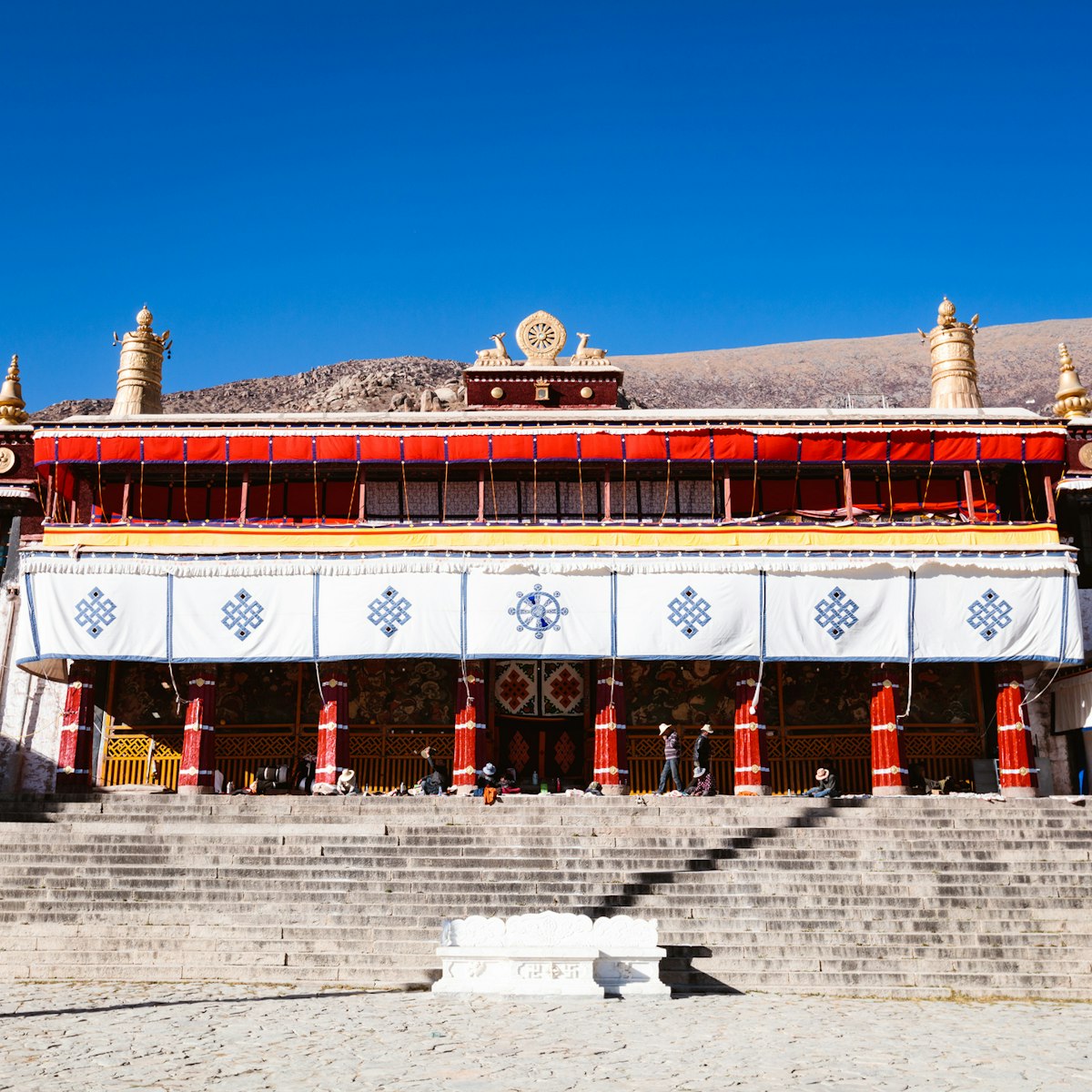Tsurphu has four main buildings and you could easily spend half a day here – longer if you plan to do the excellent outer kora (pilgrim circuit). If you're short on time, concentrate on the large central assembly hall and the upstairs former living quarters of the Karmapa.
Completely destroyed during the Cultural Revolution, the current structures date back from 1982 and reconstruction is ongoing. The monastery is home to 370 monks, with around 50 more living in seclusion in the surrounding mountains.
The large assembly hall in the main courtyard houses a funeral chörten (stupa) containing relics of the 16th Karmapa. Statues include the main central image of the first Karmapa, alongside Öpagme (Amitabha), Sakyamuni (Sakya Thukpa), and the eighth and 16th Karmapas. Pilgrims particularly venerate a small speaking statue of Sangye Nyenpa Rinpoche, a 15th-century meditation master and teacher of the eighth Karmapa. Along the right-hand wall of the hall are stacked the monastery's huge festival thangkas.
Scamper up the ladder to the right of the main entrance to visit the private quarters of the Karmapa. First up is the Karmapa’s bedroom, complete with a jigsaw puzzle of a Buddhist thangka and the Karmapa's throne. The small Audience Hall contains a footprint of the 14th Karmapa as well as a picture of the 16th Karmapa wearing his holy headgear.
Across the upper courtyard is the 17th Karmapa's bedroom, not always open to visitors, where an attendant monk inside will pat you on the back with a shoe once worn by the man himself. A quick look at the Karmapa's bookshelves reveals an interest in birdwatching and astronomy; unexpected titles include Peter Pan, The Fantastic Four and Star Wars: The Empire Strikes Back. Other boyhood possessions include a globe and a toy car.
Walking west (clockwise) around the monastery complex, you'll pass a large darchen (prayer pole) covered in yak hide and prayer flags before coming to the main protector chapel (≤µ√∂≤‘∞Ï≥Û≤π≤‘≤µ). There are five rooms here, all stuffed to the brim with wrathful deities. A row of severed animal heads, including ibex and Marco Polo sheep, lines the entry portico.
The first room is dedicated to Tsurphu’s protector deity, an aspect of blue Nagpo Chenpo (Mahakala) called Bernakchen. The third room features Dorje Drolo, a wrathful form of Guru Rinpoche astride a tiger, and the fourth room features a Tantric form of the Kagyud protector Dorje Phurba holding a ritual dagger. The fifth room contains a silver statue of Tseringma, a protectress associated with Mt Everest, riding a snow lion.
The large building behind the ≤µ√∂≤‘∞Ï≥Û≤π≤‘≤µ is the Serdung (Senlung) Lhakhang, which once served as the residence of the Karmapa. Pilgrims are blessed with sacred scriptures in the upper living room of the Karmapa. The side chapel features new statues of all 16 previous Karmapas. Look for the photos of Tsurphu before and after the Cultural Revolution, and as you approach the building from the left look up to see a golden handprint imprinted by the current Karmapa.
The Lhachen Lhakhang, which is to the right of the Serdung Lhakhang, houses a towering 20m-high statue of Sakyamuni that rises through three storeys; this replaced a celebrated 13th-century image destroyed during the Cultural Revolution. Stairs to the right outside the chapel lead to a viewing platform on the upper floor.
Most people call it quits here, but the hardcore can explore several more residences and colleges to the north, as well as the kora path that runs around the back of the Serdung Lhakhang and Lhachen Lhakhang. The yellow lhakhang to the right of the assembly hall houses a small wood-block printing press.
The outer walls of the monastery are marked at four corners by four coloured chörtens.


